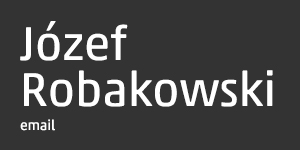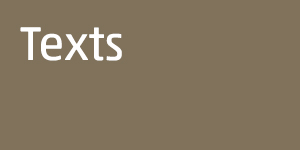Thermograms - operations on reality
Art till it hurts
Live Gallery, Lodz progressive art movement 1969-1992
'ART' friend (a memoir)
The Measure of Photography
Live Gallery, Lodz progressive art movement 1969-1992
Jozef Robakowski, (Exchange Gallery)
The book covers over thirty years of history of a group of artists who emerged from the so-called "alternative movement" which existed on the margins of the official culture in Poland under communism. The first volume covers the period between 1969 to 1981 inclusive; the second volume from 1982 to 1992. Materials for this documentary publication were prepared by the artists themselves. These artists maintained their ideological and artistic independence through individual acts and generosity rather than government grants, handouts or distribution. The movement escaped the official control thanks to the introduction into the Polish culture new, multimedial artistic language.
The so-called "other media" (multimedia installations, photography, experimental films, video, visual poetry, performance, expanded cinema, intervening actions, self-publications, occasional prints, etc.) and mail in particular, enabled artists involved in this movement to enter actively into open societal space independently from government sponsored official cultural establishments such as culture centres, arts schools, museums, galleries, cinemas, etc.
We would like to introduce this movement as a "Lodz hybrid" whose main trademark is the multitude and diversity of quasi-artistic offerings. In deciding on the collage structure of this book we would like to direct readers' attention towards the thorough exploration of the intellectual evolution of that period and not just the purely formal issues. Thus, it will be a story about a contemporary milieu in the context of the culture as well as lives of the artists themselves; something like - once put by Pawel Kwiek - "objective documentary about a man ...".
During the 70s Polish artists created some forty places all over the country where it was possible to pursue and present individual projects. Also during that time new ways of distributing independent artistic thought and ideas outside of the official channels emerged. It is these facts that form the main focus of this publication first and foremost. We avoid where possible opinions and pronouncements of art critics, art historians, or cultural anthropologists. We offer this book as an open invitation to all those interested in the state of consciousness of a group of artists who had lived during that time in Lodz. Of course, we are perfectly aware that such presentation cannot be complete - this is why we are open to any relevant amendments and corrections. The publication appears at the right moment in time - the turn of century - because this is a time for summaries and reflection on the state of the Polish culture. With this publication - put together by the artists themselves - we would like to set the record straight and refute all kinds of biased and one-sided accounts by some "experts" who methodically have manipulated Polish art history. It is because of a paucity of documents like this one that certain dishonest art historians have been able to distort the facts. It is quite ironic that during the current era of "democracy", otherwise a great authority, curator and artist - Jaroslaw Kozlowski from Poznan - in his seminal "Inne Galerie" (Other Galleries - a catalogue from an exhibition "Lekkosc Rzeczy" [Lightness of Things], Bunkier Sztuki, Cracow 1997), completely ignores the key role of artists from Lodz in the development of the alternative movement. It is truly difficult to believe that in today's democratic Poland, once again it is possible to throw away decades of dedicated and pioneering work contributed to the Polish art heritage by artists from Lodz; cynically and knowingly ignore the contribution of dedicated galleries, private spaces, or interdisciplinary art groups such as Warsztat Formy Filmowej (Workshop of Film Form) or Lodz Kaliska.
The materials collected here should also confront false opinions of Piotr Piotrowski - an art historian - who in his sloppy book titled "Dekada" (Decade - published by Obserwator, Poznan 1991) merely demonstrated his own hypocrisy and prejudice. We are also disappointed by an important retrospective exhibition that took place last year (1999) at the Warsaw's Centre of Modern Art in Zamek Ujazdowski, where the heritage of the Polish conceptual art had been presented through a simplistic and biased lens. We hope that other groups and movements, in an act of self-defense, will try to set the record straight and prepare similar self-published documents which will become a first-hand source for studies by future generations.
Art circles in Lodz often drew from 1920s and 1930s heritage. It has been an extremely important fact for us that in 1919 Lodz already had the Young Yiddish art group, probably first of its kind; totally independent from any institutional pressures, run by visual artists, musicians, writers, and artists associated with numerous theaters located here. The group comprised among others Mojzesz Broderson - a visionary and the leader of the group, Jankiel Adler, Icchak (Vincent) Brauner, Ida Brauner, Henryk Barcinski, Pola Lindenfeld, Icchak Kacenelson, Marek Szwarc, Mojzesz Neuman, and Henoch Kohn. In their first (very interesting - expressionist design) own journal they manifested their enthusiasm for the new art with the following:
Drumming the rhythm of being,
God is with us,
God of eternity,
Beauty and all Truth!
To Art! ...
Their gathering place, meetings of the editorial board, concerts and poetry readings most often took place in the Brauners' apartment (at 29 Kosciuszko Avenue) or family estate in Smardzew near Lodz. "Young Yiddish" menaged to established many contacts abroad and in Poland including Poznan Association of Artists "Bunt". The group organized original exhibitions and first interdisciplinary art happenings, e.g. in Grant Hotel's Sala Malinowa poetry reading evening "Slowa, Glos i Ton" (Words, Voice and Tone). In 1920, visual artists and young poets (Aleksander Krasinianski, Mieczyslaw Braun, Henryk Stefan Piechocki) edited a new art magazine with a title "Tanczacy Ogien" (Dancing Fire) and illustrated with expressionist typography (prints and drawings).
From 1921 Karol Hiller became a very active member of the movement - an artist open to new directions in art; and Witold Wandurski - working closely together with several young artists well-known through their association with expressionist Teatr Zydowski (Jewish Theater) and Teatr Marionetek (Puppet Theater) where Vincent Brauner worked previously. The results of those active years were presented at a well-organized "alternative manifestation" in 1923 - called "The International Exhibition of Young Art" on the premises of Lodz Casino. The exhibition was well attended by distinguished expressionists such as Erich Heckel, Max Pechstein, Wasilly Kandinsky, Oskar Kokoschka or Karl Schmidt-Rottluff, along with many Polish artists including Aleksander Rafalowski, Vincent Brauner, Henryk Stazewski, Ignacy Hirszwang, Teresa Zarnowerowna, Mieczyslaw Szczuka, Karol Hiller, Maria Nicz-Borowiakowa, Marek Szwarc, Stanis3aw Chlebowski...
Another very interesting event took place in Lodz around 1930 thanks to artists from the "a.r." group, who literally "descended" without much regard for conventions and rules on the Lodz "art society". Without doubt the instigators of this event were Strzeminski's - a couple from nearby Koluszki. This group, whose prominent members were visual artists Katarzyna Kobro, Wladyslaw Strzeminski, Henryk Stazewski, and poets including: Julian Przybos and Jan Brzekowski who called themselves "artysci rzeczywisci" (réal or factual artists) - created a new progressive environment in Poland. Thanks to their energy, dedication, and exceptional perseverance, they organized in Lodz the first Polish "International Collection of Modern Art" which found a permanent home at the Julian and Kazimierz Bartoszewicz Museum of History and Art in Lodz thanks in part to the efforts of a city official - Przeclaw Smolik. This was the greatest moment of the city's avant-garde movement. A strong conservative opposition by artists grouped in "Ryngraf" association simply collapsed under the combined weight of argumentation and evidence. The "Communiqués" following from "a.r.", excellent publications, social and educational work, systematic lectures in the local Instytut Propagandy Sztuki (Institute of Art Propagation), won Strzeminski new followers who had focussed around an ambitious alternative journal "Forma" (Form). Spontaneously, a new art circle took shape and commenced its activities; this time the members were seasoned artists such as Karol Hiller, Vincent Brauner, Katarzyna and Wladyslaw Strzeminski, Stefan Wegner, Sasza Blonder, Aniela Menkesowa, Jerzy Krauze, as well as younger artists including, among others, Juliusz Lewin and Samuel Szczekacz. The latter two clearly anticipated in their work and in interviews published in "Forma", new and original directions in art which entered into art language only much later, after the war. The war completely destroyed their work and artistic milieu. The artists focussed around "Forma" dispersed around the world; many, like Karol Hiller or Vincent Brauner, fared even worse and were murdered by the nazis. After the war, Strzeminski as one of the few surviving artists started to work on a new concept of "obrazy powidokowe" (post-image paintings). Slowly and with great difficulty, a new artistic milieu had taken shape mainly around the new state-run art schools (State Collage of the Fine Arts; State College of Film, Theater and Television; and State College of Music). However, this time there were new rules and customs imposed by the communist government and party; the combined effect of these changes destroyed all traces of individual freedom to create. Strzeminski soon had to resign from his lectureship at the Art College. Others, like Julian Przybos, attempted to fight for a freedom of expression a bit longer with texts like this one: [avant-garde]"... is a group of artists, which consciously practice an art challenging the accepted taste of the time, and resign from the immediate acceptance by the contemporary public, instead aiming towards the future. By penetrating yet unexplored areas of feeling and imagination, they revalue existing tastes and esthetic inclinations contributing to art valuation; something called "a new sensitivity"..." (Przybos, J., 1963, Sens Poetycki, Krakow, p.261).
We are already in the 1960s. Several new interesting artists are working independently: Teresa Tyszkiewicz, Jerzy Krawczyk, Stanislaw Fijalkowski, Lech Kunka, Ireneusz Pierzgalski, Stefan Wegner, Krystyn Zielinski, Leszek Rozga, Tomasz Jaskiewicz, Stefan Krygier, Andrzej Lobodzinski, Antoni Starczewski, Roman Modzelewski... . However, these artists were not able to create any free and independent artistic milieu. By and large, they preferred to participate in the initiatives conceived by other artists (e.g. they often exhibited in "Krzywe Kolo" - a well-known gallery in Warsaw). None of these artists was able to build here in Lodz, where just before the war there were "Young Yiddish" and "a.r.", anything similar, free of institutional meddling, official labour unions, or state sponsorship. It was not until the stage was entered by new artists from outside of Lodz that a change had finally begun. Specifically, I have here in mind members of the group ZERO-61 from Torun, who moved to Lodz around the second half of the 1960s. The group comprised of Wojciech Bruszewski (the only member originally from Wroclaw), Jozef Robakowski, Antoni Mikolajczyk and Andrzej Rozycki. Many years of interdisciplinary activities of this group in Torun (film, photography, other visual arts, texts, art interventions) combined with excellent organizational skills used to organize progressive movement outside the official channels in Poland, enabled these completely unknown newcomers a quick impact on the local scene. The final gesture of the group in Torun; this time calling themselves ZERO-69, was an unusual exhibition titled "Kuznia" (a forge) whose participants systematically derided the so-called "object of art" by adopting the premises of an old forge in their own artistic gesture. The next step involved a conception in Lodz of a new progressive group, this time within the Film School and under the name Warsztat Formy Filmowej (Workshop of Film Form). This group of school graduates and students begun its work under the aegis of the Science Club in order to break away from the routine curriculum served at the time in the Film School. The Warsztat begun its activities as a group with an open multimedia and research program from 1970 onwards. By coincidence, the configuration of the alternative art scene in Lodz had been taking shape more or less at the same time. The work of Krystyn Zielinski, Andrzej Lobodzinski, Jerzy Trelinski, Andrzej Pierzgalski and Ewa Partum moved away from the traditionalist creations of artists unionized in ZPAP (Association of the Polish Visual Arists - an official, state-run, artists' union) who were usually exhibiting at the state-run BWA gallery (Biuro Wystaw Artystycznych - The Office of Art Exhibitions). During the same period, the pedagogic and artistic work of Zbigniew Dlubak begun to play a very important role among the young artists in Lodz; he was a Warsaw artist who offered very interesting photography courses at the Film School and Art College. Many his students opened up themselves towards new interpretations of understanding and essence of art. For the most part, this new and vigorous movement existed outside of the official art school curricula; and was self-taught.
Meanwhile, another strong artistic personality entered the Lodz scene - I am thinking here about Zbigniew Warpechowski who came here from Cracow. Also, at the end of the 70s, Edward Lazikowski - a sculptor and performer - influenced art in Lodz. During the Festival of the Art Schools in Nowa Ruda (in 1971), an integration of multimedia artists took place - the attending artists proclaimed that from then on they want to work closely together. Since then, an intricate network of contacts took shape along with many friendships which cemented many artists for the rest of their lives. The Warsztat Formy Filmowej created first collection of films (purely non-commercial and experimental) shown at numerous revues and shows all over Poland (Cracow, Lublin, Poznan, Gdansk, Warszawa, Lagow, and more). Also a new independent distribution channel emerged thanks to dedicated private galleries, clubs, and occasionally museums. During that time the theater of absurd - Edward Kowalski Theater of the Retired with (self-proclaimed actor) Waclaw Antczak as the main character - was very active on the edges of culture. Many other well-prepared events took place ignoring artificially blown-up, pompous state events and festivals for the general public (e.g. Zakopane, Lagow, Gdansk, Zielona Gora, etc.). Between 1971 and 1975 first collection of films from the Warsztat was supplemented by new entries including Zbigniew Rybczynski, Ryszard Wasko, Pawel Kwiek, Tadeusz Junak, Marek Koterski, Ryszard Gajewski, Ryszard Lenczewski, Wojciech Bruszewski, Jozef Robakowski and others. Frequent, well-prepared, and ideologically independent shows attracted the attention of foreign media. The flourishing pen art slowly penetrated, up until now "impenetrable", iron curtain.
Finally, for the first time since the Second World War new, ambitious, non-commercial galleries emerged including Galeria 80x140 of Jerzy Trelinski, Galeria A4 of Andrzej Pierzgalski, Galeria Adres of Ewa Partum, Galeria Na Pietrze of Tadeusz Porada, Miroslaw Woznica and Bogna Stawicka together with Grzegorz Sztabinski. There was a multitude of self-published samizdats cleverly circumventing state censorship (Zeszyty Warsztatu), occasional newsletters and limited edition books and booklets by Galeria Adres, as well as galleries of Trelinski and Pierzgalski. Also, there were plans to create unofficial journal dedicated to art theory (the proposal was prepared by Wojciech Bruszewski and Jozef Robakowski) with a nation-wide distribution; unfortunately the idea never materialized because of financial problems. At that time, yet another completely new artistic movement emerges in Lodz under the name VIDEO, while at the Wytwornia Filmow Oswiatowych (Educational Films Studio) and SeMaFor (Animated Films Studio) innovative, professionally produced films about distinguished Polish avant-garde artists from the past and present were created. These films publicly evoked the names of Katarzyna Kobro, Wladyslaw Strzeminski, Tytus Czyzewski, Leon Chwistek, Witkacy (Stanislaw Ignacy Witkiewicz), members of the Polish constructivist movement, group "a.r.", Alina Szapocznikow, Henryk Stazewski and many unconventional contemporary artists (in films "Zywa Galeria" [Live Gallery], "Krzesla" [Chairs]), who until that time were considered by the official "experts" not worthy remembering. Poets also managed to evade the state control and established an ambitious underground journal "Puls" (Jacek Bierezin, Tomasz Filipczak, Witold Sulkowski, Tadeusz Walendowski from Warsaw, and others). Zdzislaw Jaskula with his wife Slawa became very active in the art milieu and organized in their private flat at Wschodnia Street an outpost of alternative and independent thought. Also active was Teatr 77 (Theater 77) of Zdzislaw Hejduk. However, the centre of independent productions or Stowarzyszenie Tworcow Kultury (STK - the Association of Culture Creators) directed by the artists themselves had become for the communist local government synonymous with everything subversive and dangerous; i.e. nonconformist artistic attitude. By the end of the 70s, many new alternative associations had emerged in Lodz, e.g. Zespol T (with Janusz Szczerek, Andrzej Paruzel, Tomasz Konart, Piotr Weychert, Janusz Kolodrubiec) and Lodz Kaliska (with Marek Janiak, Andrzej Kwietniewski, Andrzej Wielogorski, Andrzej Swietlik and Adam Rzepecki who commuted from Cracow).
During that time two large scale international meetings - Sztuka Niezidentyfikowana (Unidentified Art) and Teksty Wizualne (visual texts) were organized by STK. The latter event was attended by around a hundred and twenty artists from all over the world; they were invited to the event by an outstanding Czech critic and artist Jioi Valoch from Brno. All works, many of them unique, were donated by STK to the Lodz Museum of Art. At the end of the 70s, the Museum became a place where Janusz Zagrodzki - the curator of the museum - had systematically implemented his ambitious program and opened a new gallery Slad (Trace) on the premises of STK. In 1978, Malgorzata Potocka and Jozef Robakowski organized in their apartment Galeria Wymiany (Exchange Gallery) which, over time, became the largest archive and collection of progressive art in Lodz. The next important neo-avant-garde art space became Artforum, where young art enthusiasts including Hanka Nowicka and Wieslaw Michalak were expertly led by Tadeusz Porada; the artistic direction of the gallery was supervised by Zbigniew Warpechowski determined to introduce the performance art to a wider audience in Poland.
In summarizing that decade I should mention several important exhibitions and retrospectives in Poland and abroad attended by progressive artists from Lodz. These included Fotografowie Poszukujacy in Warsaw (Searching Photographers), Kinolaboratorium in Elblag (Laboratorycinema), Zjazd Marzycieli in Elblag (Dreamers' Rally), Atelier 72 in Edinburg, XII Biennale in Sao Paulo, Oferta I and II in Lublin (Offer I and II), V Festival Filmow Eksperymentalnych in Knokke-Heist (V Festival of Experimental Films), Film als Film in Cologne (Film as Film), 5 Festiwal Video in Antwerp, Osieki 1974 in Osieki, Fotografowie Poszukujacy in Cologne, Akcja Warsztat in Lodz (Action Workshop), Aktualna Sztuka Europy Wschodniej in Antwerp (Recent Art of Central Europe), Aspekty Nowoczesnej Sztuki Polskiej in Warsaw (Aspects of the Modern Polish Art), Film international show of independent film in Warsaw, Sztuka Kontekstualna in Lund, Amsterdam, and Padua (Contextual Art), Pokaz Sztuki Progresywnej in Amsterdam (Progressive Art Show), Video Art in Lublin, Lodz, and Warsaw, Film as Film in London, Sztuka Jako Realnosc Mechaniczna in Lodz (Art as a Mechanical Reality), Poezja Wizualna in Lublin and Lodz (Visual Poetry), Stany Graniczne Fotografii in Katowice (The Outer States of Photography), exhibitions of Warsztat Formy Filmowej in Moscow, Hamburg, Kopenhagen, Oslo, Edinburg, Padua, Zagreb, Essen, Paris, New York, Amsterdam, Prague, Vien, Zurich, Documenta 6, 7, and 8 in Kassel, Fotografia jako Sztuka - Sztuka jako Fotografia (Photography as Art - Art as Photography) in Kassel, Linia in Budapest (a line), Works and Words in Amsterdam.
It is not possible to list here all important activities organized by these artists and which broke all barriers, limits, borders as well as determined opposition by the communist authorities. The new decade brought about a summation of new esthetic values worked out during the 1970s - in other words the great retrospective exhibitions of the alternative movement. In Lodz there were plans to organize in 1980 a retrospective exhibition - Sztuka Progresywna lat 70 (the Progressive Art of the 70s) - however, the executive of the local Office of the Art Exhibitions (BWA) did not accept the plan and, instead, organized on its own a "socialist" festival for the youth. All the same, by a pure accident (because of a sympathetic executive director) the plan was taken up by the BWA in Sopot in 1981 under the title 70-80: Nowe Zjawiska w Sztuce Polskiej Lat 70 (New Phenomena in Polish Art of the 70s). The exhibition was curated by Jan Swidzinski, Jozef Robakowski, and Witoslaw Czerwonka. It was a sizable manifestation of around forty Polish independent galleries, alternative spaces, various individual theoretical concepts, self-financed publications, occasional newsletters, photographic, film and television documents. It is important to note here that contrary to the views propagated by Piotr Piotrowski (an art historian and author of "Decade" mentioned earlier - a falsified account of those times), the Sopot retrospective was a great event organized solely by many artists and gallery owners without any remuneration, advertising or significant reward of any kind by the state authorities. The only publication of this exhibition was my self-published book titled "Teksty-Koncepcje" (Texts-Concepts) and reproduced on a photocopier in only 100 copies; today a priceless anthology of texts by nearly all significant artists of the 70s. The publication of these texts was done with no honoraria, for internal use only. The next great exhibition of the 1980s (also ideologically suspect according to Piotrowski) was Konstrukcja w Procesie I (Construction in Process I) in Lodz organized by the so-called Grupa Pracy (group of work) put together and led by a daring young assistant professor of the Film School - Ryszard Wasko; also a member of the Committee for the Renewal of the Film School. Today, from a hindsight, it can be safely concluded that the Construction in Process I was by far the most important international art meeting in Poland under communism. It took place because of the politically and socially favourable conditions created by the Solidarity movement and, therefore, without any pressure form the official state sponsored "experts". The city benefited in an unprecedented manner, through a gift from Solidarity which donated the works of art created by distinguished western artists during the exhibition to the local Museum of Art. The main event was accompanied by a show titled Falochron (Breakwater) devoted to Polish artists and curated by Antoni Mikolajczyk closely linked to the Lodz art milieu.
During the preparatory work for the Construction in Process I and Falochron, a new and quite unique gallery emerged in Lodz. The gallery was called enigmatically Galeria Czyszczenie Dywanow (Carpet Cleaning Gallery) and led by Radoslaw Sowiak and Adam Paczkowski. At first, this interesting undertaking by the people from "nowhere" had been treated with a great deal of suspicion by the "alternative society". The so-called Dywanowcy (carpet cleaners), however, turned out to be very active and organized in their tiny gallery-space-apartment many interesting meetings, auctions and exhibitions. They also published very conspiratorial (because the martial law - 1982-1983 - was very much in place) journal called Mersapon (the title was a play on words - Mersapon was one of the most popular chemicals for cleaning carpets) devoted to the alternative art movement. Concurrently, another gallery Strych (the Attic) was organized and quickly became the meeting place of the members of Lodz Kaliska and Film School graduates Jacek Jozwiak and Tomasz Snopkiewicz. In spite of the restrictions imposed by the martial law, many private meetings, outings, and private shows were organized all over the country. Spontaneously the so-called Kultura Zrzuty (the Chip-in Culture) took shape. It embraced joined initiatives of practically entire underground "alternative society" across the largest Polish cities. The result of these meetings were several very interesting actions organized by the artists themselves - 7 Dni Stworzenia Swiata (7 Days of World Creation) an outing in Cracow - Urodziny w Lazni Miejskiej (Birthday in the Public Bath) in Warsaw - three editions of Nieme Kino (Silent Cinema) in Lodz, Zjazdy (Rallies) in Kazimierz nad Wisla, Koleda (Christmas Song) in Koszalin, joined production of a film Panstwo Wojny (War State) in Osiek near Torun, Tango in Warsaw, Pielgrzymka Artystyczna (Artistic Pilgrimage) in Lodz, outings in Teofilow (a suburb of Lodz), and many more. Also very active at that time was STK; it is here at the flat of Mariella Nitoslawska and Janusz Polom that planning for a very large international meeting of the independent filmmakers Forward took place. Because secret service censorship was closely monitoring our mail and meetings it was able infiltrated this initiative. Consequently, the state authorities denied invited guests entry visas to Poland. Still, in 1981 during a meeting in Budapest we were able to organize an international film co-operative Infermental with great input by a distinguished Hungarian film maker Gabor Bódy. During the martial law in Poland, the Hungarian students were smuggling our video productions through sealed for us borders. Infermental distributed our work world-wide and it became one of the first of its kind video journals anywhere in the world. Thanks to these people our films entered the mainstream of the world art already during the martial law. However, not all was well, interrogations, arrests, house searches multiplied while frequent confiscation of priceless parcels that included books, videotapes, and films made any meaningful exchange at best difficult. Finally the confiscation of passports of many independent artists reduced possibilities of contacts with the world "outside" to nil. At the Film School, where many of us worked at that time, the hard won reforms were reversed. We had to retreat! The new administration of the School, which was appointed entirely by the authorities, brought back the pre-Solidarity structure. As a result, virtually all younger lecturers left the School.
In spite of these setbacks, the progressive movement in Lodz flourished. Many underground publications emerged including Fabryka (the Plant), several editions of Lodz Kaliska journal Tango appeard; there were two editions of PST - czyli Sygnia Nowej Sztuki, there were new films, video works, exhibitions, occasional newsletters, art objects, photographs and excellent posters (e.g. Tadeusz Piechura and Maciej Nowakowski). It was this movement from which emerged an extremely interesting initiative by Alexander Honory and Wojciech Grochowski titled Prawdziwe Brzmienie Lodzi (the True Sound of Lodz); it energized several alternative rock bands from all over Poland. That concert broadened the reach of the alternative music scene - until then available only to a very narrow following - and exposed a new energy and vitality of the movement. It was during that event, attended for a first time by such a large (over thirty) number of performers, that a band Moskwa (Moscow) was discovered. Together we had managed to finance with our own funds professional production of many recordings as well as produce and distribute several, today considered classic, video clips which popularized the group. The movement had its omnipresent peers and colourful personalities including Wojciech Czajkowski, Wlodzimierz Kiniorski, and Jacek Bielenski; they were authors of many intriguing concerts all over the country. Wojciech Czajkowski was also the author behind two film editions of the Construction in Process, while Wlodzimierz Kiniorski worked together with a film director Jacek Jozwiak during his television and film projects. In spite of the many obstacles, the 80s brought about new valuable films about art; for example Malgorzata Potocka directed films about Krzysztof Zarebski, Zbigniew Warpechowski, Edward Krasinski, Jan Dobkowski, Ryszard Winiarski, Boguslaw Schaeffer; while Ryszard Wasko about Henryk Stazewski, Andrzej Rozycki about Zofia Rydet, Piotr Zarebski about Franciszka and Stefan Themerson. There was also a series of excellent video-clips directed by Bartol Lukia, Ted Ciesielski, Hubert Taczanowski, Malgorzata Potocka and Andrzej Wyrozebski for Kora, Kult, Siekiera, Republika, and so on. Meanwhile Exchange Gallery begun on its own to document various alternative events taking place in the country, including video documentation of Jarocin Festival, performances by Zbigniew Warpechowski, Andrzej Partum, Ewa Zarzycka, Jerzy Truszkowski, Barbara Konopka, Marek Janiak, Pawel Kwasniewski, and many others. Similar initiative was undertaken by Janusz Kolodrubiec, Jacek Jozwiak and Andrzej Janaszewski.
During 1987, Polish video movement took shape through distribution on Video-Art-Clip exhibition (three editions by the Exchange Gallery). However, regular distribution of video and experimental films was undertaken only towards the end of the 1980s by the excellent expert in this field and organizer Ryszard Kluszczynski. This revitalization of video artists prompted Violetta and Piotr Krajewski together with Zbigniew Kupisz to organize a large international multimedia festival in Wroclaw. WRO to this day is considered as one of the most important reviews of its kind in Europe.
As the result of interest in our work by the Channel 2 of the Polish Television, many of our projects were finally broadcasted through a nation-wide media; Art-Noc (Art-Night) thanks to Jerzy Kapuscinski and Marcin Krzyzanowski begun its broadcasts at the second half of the 80s. That time coincided with a great explosion of artistic energy. An abandoned apartment at Wschodnia 29, was illegally taken over by a theater-music (AiP) group brought about by Jaroslaw Orlowski, Piotr Bikont and Wojciech Czajkowski. The place becomes an excellent new space - I mean here, of course, Galeria Wschodnia (East Street Gallery) led from the very start by Adam Klimczak and Jerzy Grzegorski. By coincidence, this is also when STK grouped around Lodz SPATiF (an official Association of Polish Performing Artists with a club at Kosciuszki Avenue) reached a crisis point and the corrupt city authorities closed down the premises. Galeria Wschodnia from that point on have become the only gathering and exhibition space for the independent art movement in Lodz.
Small apartment galleries, such as Slad of Janusz Zagrodzki, U Zochy, or Czyszczenie Dywanow, or even Strych, died slowly of natural causes. However, some still function; apartment-space of Bozena and Andrzej Chetko, Punkt Konsultacyjny of Antoni Mikolajczyk, and Exchange Gallery which organized in 1986 a large meeting called Swiatlo Ciszy (Light of Silence) and exhibition of the gallery collection titled Obrazy (Pictures). However, we shall return to Galeria Wschodnia, which in practice is also a private apartment turned gallery because their permanent inhabitants became Ewa Robak and Adam Klimczak (married at that time). They welcomed to their place everybody. The gallery quickly became an oasis of creative freedom for Polish and foreign artists. I am sure that during the 80s this was THE private gallery; the most important private gallery in the country. Thanks to the uncommon tolerance, selfless hard work, and dedication of the hosts, the place became the catalyst for many very important events, individual and group exhibitions, performances, meetings, discussions or simply a place to stay for a while. Many large projects by distinguished artists took place at Wschodnia; for example Antoni Mikolajczyk Postawy (Attitudes) or, by the same artist, international art meeting Utopia i Rzeczywistosc (Utopia and Reality); and other authors - Zdzislaw Mich and Wojciech Krolikiewicz theater called Kici Koci, it is here where the famous performance group Black Market presented their work, two large international festival Video-Art-Clip and Videoperformance took place as well as countless individual and group shows until and including Construction in Process III. The next generation of "progressives" was growing up in opposition to this place; the artists grouped in the Pomaranczowa Alternatywa (Orange Alternative) and Galeria Maniakalna (Maniac Gallery) from which later on emerged very active fraction Wspolnota Leeezec specializing in ruthless criticism of the middle-class mentality, all grew up around Wschodnia. Another alternative group Lodz Fabryczna emerged in part as an offspring of Wschodnia; the group specialized in organizing absurd concert-objects.
It is important to note, that another welcoming place to the alternative movement was Teatr Studyjny (Studio Theater), which hosted co-operative gallery of Jolanta Ciesielska. For us, Lodz artists, one of the most important tasks was keeping in touch with the like-minded artists. Many of them have been our close associates and friends always ready to join in a common initiative or undertaking; some of them are Zygmunt Rytka, Witoslaw Czerwonka, Jan Swidzinski, Jerzy Truszkowski, Zbigniew Libera, Ewa Zarzycka, Elzbieta Kalinowska, Andrzej Kostolowski, Anna Plotnicka, Adam Rzepecki, Jacek Kryszkowski, Andrzej Mroczek, Jerzy Ryba, Mikolaj Smoczynski, Tomasz Wozniakowski, Andrzej Ciesielski, currently living in Sandomierz Zbigniew Warpechowski, Pawel Kwiek, Ewa Kulasek, Marek Kijewski, Wlodzimierz Borowski, Izabella Gustowska, Natalia LL, and many others. At the end of the 80s, finally we had succeeded in reviving the old, waiting for the better times, project from 1979 - Sztuka Innych Mediow (the Other Media Art). Museum of Cinematography gave the helping hand to the project and on the May 18, 1989 Lochy Manhattanu (the Dungeons of Manhattan) too place in Lodz. The show lasted for a whole month and, this time, its main objective was to break the hegemony of the non-expressionistic painting which ruled Polish official and unofficial painting for over a decade.
This fashionable and de rigeur then "art of the wild" at one point became intolerable because of the uncritical acceptance and sanctioning by museums (even the National Museum joined in the rush), all kinds of official galleries, art schools (except the Lodz Art Academy), art dealers and the self-proclaimed, so-called art experts. After 1985, the trend became safe, popular, and certainly redundant by comparison to naturally evolving elsewhere new media art. Even worse, the movement as a well understood and accepted phenomena was cleverly incorporated by the official authorities for the use in the so-called "changes" at the end of the 80s. Although the critique was dressed up in a humorous and carefree sarcasm, full of youthful energy and cockiness, in reality it perfidiously leveled out the entire heritage of the 60s and 70s, accusing it of collaboration with the communist authorities, shallowness of the conceptual novelties, apoliticism, and (sic) cosmopolitanism.
Lochy Manhattanu was a great manifestation of over hundred and twenty progressive artists of various generations and disciplines. It brought back to order the unfortunate state of affairs in the Polish art community. Art as such, achieved its rightful place as it threw away false pretences, and stopped serving various political manipulations. This "cleansing" was again confirmed by many Lodz artists in the next large manifestation in 1992 (Grohman Palace) as the followers of neo-avat-garde. This was also time of Artysci Osobni (Separate Artists) who, without doubt, included Jerzy Zachara, Maciej Walczak, Slawomir Belina, Andrzej Paruzel with his Office of Art and Culture Guides, Leszek Golec, Malgorzata Borek, and finally Krzysztof Cichosz who is both an artist and boss of the Galeria FF with its own alternative program. It is important here to mention also Edward Lazikowski who programmatically does not want to be associated with avant-garde, a recluse Andrzej Janaszewski and Wojciech Bruszewski, Andrzej Rozycki, Maria Wasko, Wieslaw Barszczak, Jacek Jozwiak, secretive poet Mariusz Olszewski, Leonard Grabowski, Andrzej Chetko, Barbara Konopka, Witold Krymarys, increasingly intriguing poet Lucyna Skompska, Konrad Kuzyszyn, Zbigniew Dudek, and many quite young artists already active in the 1990s including Jacek Mrozowicz, Jakub Jakubowski, Tomasz Matuszak, Mariusz Soltysik, Wojciech Leder, Cezary Bodzianowski, Tatiana Czekalska, Maciej Cholewinski, Robert Rabiega and Marcel Zamenhoff. The 1990s focussed the activities of most of these artists in the Muzeum Artystow (Artists' Museum), created during Construction in Process in the 1990 under the banner Back to Lodz; Emmett Williams - one of the founding members of Fluxus - became the president of the Museum.
Artists' Museum did not want to be a conventional museum tied to any particular place, administration or collection; it functions as an international community of artists. All work at the museum voluntarily and for free. Thanks to such work, several branches have been opened all over the world, including offices in New York City, Sydney, Tel-Aviv, Cardiff, and Berlin. However, the coordinative centre remains in Lodz. As a result of the work put in by the youngest members of the movement and contacts cultivated by the so-called other spaces, three editions of national meetings titled Marcowe Gody (March Festivities) were organized in the city. Equally interesting were exhibitions of the artists visiting from Gdansk and Poznan, as well as international symposium Candid Camera organized by the students of the Film School among other events in the tradition of Lodz progressive movement. It appears, that all of these people grouped in the independent progressive movement pay homage to the so-called "new sensibility", about which - long time ago still in the 60s - thought Julian Przybos.
At the Marcowe Gody I saw many such followers of free art, some of them where even drunken with happiness...
Lodz 1995-1997







